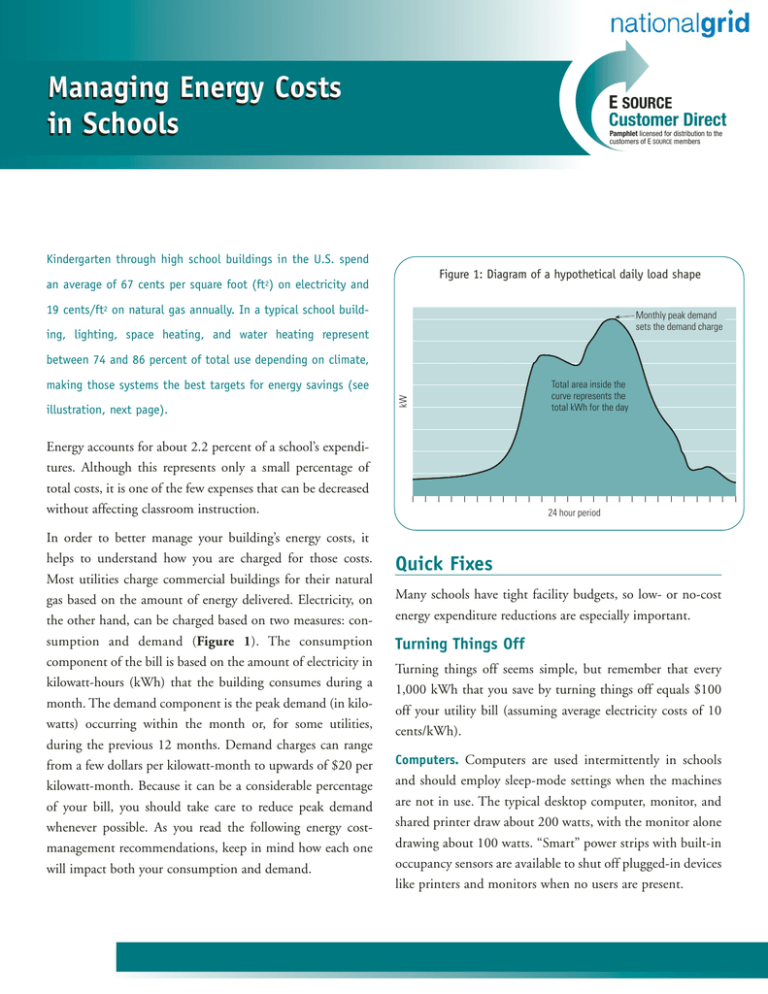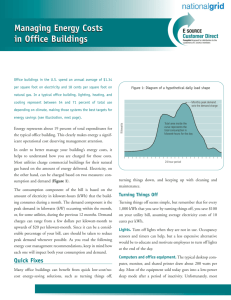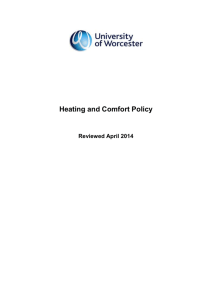Managing Energy Costs in Schools Managing
advertisement

Managing Energy Costs in Schools E SOURCE Customer Direct Pamphlet licensed for distribution to the customers of E SOURCE members Kindergarten through high school buildings in the U.S. spend Figure 1: Diagram of a hypothetical daily load shape an average of 67 cents per square foot (ft2) on electricity and 19 cents/ft2 on natural gas annually. In a typical school build- Monthly peak demand sets the demand charge ing, lighting, space heating, and water heating represent between 74 and 86 percent of total use depending on climate, illustration, next page). kW making those systems the best targets for energy savings (see Energy accounts for about 2.2 percent of a school’s expenditures. Although this represents only a small percentage of total costs, it is one of the few expenses that can be decreased without affecting classroom instruction. In order to better manage your building’s energy costs, it helps to understand how you are charged for those costs. Most utilities charge commercial buildings for their natural gas based on the amount of energy delivered. Electricity, on the other hand, can be charged based on two measures: consumption and demand (Figure 1). The consumption component of the bill is based on the amount of electricity in kilowatt-hours (kWh) that the building consumes during a month. The demand component is the peak demand (in kilowatts) occurring within the month or, for some utilities, during the previous 12 months. Demand charges can range from a few dollars per kilowatt-month to upwards of $20 per kilowatt-month. Because it can be a considerable percentage of your bill, you should take care to reduce peak demand whenever possible. As you read the following energy costmanagement recommendations, keep in mind how each one will impact both your consumption and demand. Total area inside the curve represents the total kWh for the day 24 hour period Quick Fixes Many schools have tight facility budgets, so low- or no-cost energy expenditure reductions are especially important. Turning Things Off Turning things off seems simple, but remember that every 1,000 kWh that you save by turning things off equals $100 off your utility bill (assuming average electricity costs of 10 cents/kWh). Computers. Computers are used intermittently in schools and should employ sleep-mode settings when the machines are not in use. The typical desktop computer, monitor, and shared printer draw about 200 watts, with the monitor alone drawing about 100 watts. “Smart” power strips with built-in occupancy sensors are available to shut off plugged-in devices like printers and monitors when no users are present. Energy consumption by end use in schools for five U.S. climate zones Climate zone 2 Climate zone 1 Office equipment Refrigeration 2% 1% Miscellaneous Refrigeration Office equipment 2% 1% Miscellaneous Cooking 2% 3% Lighting 26% Water heating 26% 36% Water heating Ventilation 1% Climate zone 4 Refrigeration 2% Miscellaneous 2% Lighting 29% Water heating 20% 29% Office equipment 2% Miscellaneous 5% Lighting 25% Cooling 4% Ventilation 2% 28% Water heating 25% Heating Cooling 10% Ventilation 2% Climate zone 5 Office equipment 3% Cooking 2% Cooking 2% Heating 30% Lighting 21% Cooling 5% Refrigeration 1% 2% Cooking 2% Heating 34% Climate zone 3 Heating Cooling 10% Ventilation 3% Office equipment 3% Miscellaneous Refrigeration 5% 2% Heating Cooking 20% 2% Cooling 36% 9% Lighting Ventilation 5% Water heating 18% Climate zones Zone 1 is less than 2,000 CDD and greater than 7,000 HDD. Zone 2 is less than 2,000 CDD and 5,500–7,000 HDD. Zone 3 is less than 2,000 CDD and 4,000–5,499 HDD. Zone 4 is less than 2,000 CDD and less than 4,000 HDD. Zone 5 is 2,000 CDD or more and less than 4,000 HDD. Note: CDD = cooling degree day; HDD = heating degree day Lights. Turn off lights when they are not in use. Occupancy sensors can help, but a less-expensive alternative would be to assign students as “energy monitors” to ensure that switches are off when the lights aren’t needed and to train custodial staff to also switch off lights. The Albuquerque, New Mexico, public school district is allotting a third of the savings from energy-efficiency © 2002 E Source Companies LLC Source: U.S. Energy Information Administration initiatives to the administration for spending on educational needs, in order to reward schools that conserve. Turning Things Down Some equipment cannot be turned off entirely, but turning it down to minimum levels where possible can save energy. HVAC temperature setbacks. Turn down temperature settings after school hours but be wary of nights when after-school activities such as sports or theater occur. are intact so no air leaks out of the cabinet. Chilled air leaking out can cost $100 per rooftop unit per year in wasted energy. Special-use rooms. Certain parts of a school—like Clean condenser coils. Check condenser coils quarterly auditoriums, gymnasiums, and cafeterias—are only used during specific times of the day or week. Make sure that HVAC settings are at minimum levels during nonuse periods. for either man-made or natural debris that can collect there. At the beginning and end of each loading season, thoroughly wash the coils. Water heaters. Turn water heaters down on weekends if possible. Cleaning and Maintenance Use an economizer. Many air-conditioning systems use a dampered vent called an economizer to draw in cool outside air, when it is available, to reduce the need for mechanically cooled air. If not regularly checked, the linkage on the damper can seize up or break. An economizer stuck in the fully opened position can add as much as 50 percent to a building’s annual energy bill by allowing in hot air during the air-conditioning season and cold air during the heating season. Have a licensed technician check, clean, and lubricate your economizer about once a year and repair it if necessary. If it’s still operating, have the technician clean and lubricate the linkage and calibrate the controls. Check air-conditioning temperatures. With a ther- mometer, check the temperature of the return air going to your air conditioner and then check the temperature of the air coming out of the register nearest the airconditioning unit. If the temperature difference is lower than 14 degrees or higher than 22 degrees, have a licensed technician inspect your air-conditioning unit. Change filters. Filters should be changed on a monthly basis—or more often if you are located next to a highway or construction site where the air is much dirtier. Check cabinet panels. On a quarterly basis, make sure the panels to your rooftop air-conditioning unit are fully attached with all screws in place, and verify that gaskets Check for airflow. Hold your hand up to air registers to ensure that there is adequate airflow. If there is little airflow or if dirt and dust are found at the register, have a technician inspect your unit and ductwork. Longer-Term Solutions Longer-term solutions should also be considered. Although the actions covered in this section require more-extensive implementation, they can dramatically increase the efficiency of your facility without compromising the learning environment. Ask your local utility’s representative for more information about initiating such projects. Commissioning Commissioning is a process in which engineers observe a building to ensure its systems are operating appropriately and efficiently. Studies have shown that continuously monitoring a building’s energy systems can lead to reductions of 10 to 15 percent in annual energy bills. For the typical 100,000-ft2 school building, that’s equal to about $14,000 in savings per year! Savings typically come from resetting existing controls to reduce HVAC waste while maintaining or even increasing comfort levels for occupants. Commissioning usually costs between 5 and 40 cents/ft2. Upgrade to More-Efficient Lighting Take advantage of daylighting where possible to reduce the need for electric light—proper design is critical to avoid glare and overheating. If your facility uses T12 fluorescent lamps, relamping with modern T8 lamps and electronic ballasts can reduce your lighting energy © 2002 E Source Companies LLC consumption by 35 percent. Adding specular reflectors, new lenses, and occupancy sensors or timers can double the savings. Paybacks of one to three years are common. Compact fluorescent lamps (CFLs) can replace incandescents in many applications, reducing energy use by two-thirds and yielding savings of up to $20 per lamp per year. Efficient Water Use Sink and shower controllers that automatically shut off after a certain time duration and low-flow faucets and shower heads can help conserve energy used to heat hot water. Demand-Controlled Ventilation Many auditoriums, gyms, classrooms, and cafeterias are always ventilated as if they were at full capacity. Instead of leaving them this way, adjust the ventilation levels based on occupancy. Demand-controlled ventilation manipulates an HVAC system to control the amount of outside air being supplied to a space based on occupancy, as measured by the amount of carbon dioxide present in that space. Less energy is consumed because the fans only run when outside air is needed. Reflective Roofing If the roof needs recoating or painting, consider white or some other highly reflective color to minimize the heat that the building absorbs. This change can often reduce peak cooling demand and cooling energy use by 15 to 20 percent. For a list of suitable reflective roof-coating products, check out the U.S. Environmental Protection Agency’s Web site at http://yosemite1.epa.gov/estar/ consumers.nsf/content/roofbus.htm. © 2002 E Source Companies LLC Explore New Ways to Heat and Cool Your School If you are planning a comprehensive renovation of your heating and cooling system, consider some energyefficient alternatives: Geothermal heat pumps. Also known as ground-source heating and cooling, these rely on the thermal stability of the ground to heat and cool a building. Because the ground temperature below the frost line remains constant throughout the year, it can be used as a heat source in the winter and a heat sink in the summer. The first cost of a geothermal heat pump can be slightly higher than that of other systems, but life-cycle costs are often lower. Energy consumption from geothermal heat pumps can be 25 to 50 percent less than that of traditional heating and cooling systems. Evaporative cooling uses the natural cooling of evapo- ration and is especially effective in warm, dry climates. It typically uses less than 25 percent of the energy of a vapor-compression air-conditioning system. First costs may be higher than for a vapor-compression system, but paybacks can be rapid: six months to five years depending on climate. The Bottom Line Almost all of the conservation measures discussed here represent good investments. Most will not only save money but will enhance both the aesthetics and the learning environment of your school building.



